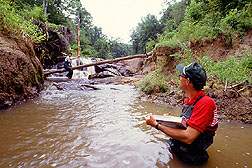Science Update
|
|
Sticks and Stones May Brake Erosion
In silty southern streams, sticks and stones --willow posts and limestone rocks --can protect bluegill, bass, and catfish from the effects of erosion caused by watershed development. More roads, roofs, and fields mean more rainwater reaching streams more quickly with greater erosive punch. That's why Agricultural Research Service, the U.S. Army Corps of Engineers, and USDA's Natural Resources Conservation Service in 1994 developed a cooperative project to restore stream and creek habitats. As part of the effort, ARS conducted a 3-year study to determine which of the two stabilizing techniques would be more effective in restoring fish habitat in a stream damaged by extreme erosion. The limestone seemed slightly better, based on diversity and number of fish, but the willows are more economical. The 7- to 20-foot dormant willow posts, planted in the streambanks, come to life in spring and grow sturdy roots to protect the bank from erosion. Piles of limestone rock --formed into ridges perpendicular to the current or parallel with the bank --deflect currents and hold slumping banks in place.
F. Douglas Shields, Jr., USDA-ARS National Sedimentation Laboratory, Oxford, Mississippi; phone (601) 232-2919.
Two Proteins Determine Wheat Texture
ARS scientists have identified the elusive molecular basis for wheat texture, referred to as hardness or softness. Generally, hard wheats are for breads; soft wheats, for cookies and cakes. The discovery should help breeders develop super-soft and other custom wheats. ARS researchers have shown for the first time that two proteins called puroindolines --pinA and pinB --correlate perfectly with wheat texture. All soft wheats have pinA and a specific form of pinB that has glycine as its 46th amino acid. Most hard wheats differ from soft wheat only in having serine as the 46th amino acid in pinB. The other hard wheats tested have the glycine pinB and no pinA at all. With traditional breeding or biotechnology, scientists could develop varieties with specific puroindoline combinations. By boosting levels of soft-wheat puroindolines, for example, they might create a super-soft variety for making new kinds of cakes and cookies. That's because millers could grind the grain more finely than is now possible without damaging the starch, a common milling problem.
Craig Morris, USDA-ARS Western Wheat Quality Laboratory, Pullman, Washington; phone (509) 335-4055.
Spud Book Holds 4,000 Pedigrees
A new compilation of more than 4,000 pedigrees of North American and European potato varieties is available for the first time to potato breeders and industry. An ARS geneticist compiled the handbook in collaboration with scientists based in Poland, the Netherlands, and Ireland. The handbook gives information on a variety's origin, year of release, countries of cultivation, female and male parents, source or list of references, and unreleased ancestors of currently cultivated varieties. Scientists compiled the information from breeders and institutions preparing parental lines for breeding in the United States, Europe, and Russia. In North America, the pedigrees are computerized and also published in the American Potato Journal. European varieties, however, are often released without publishing pedigree information. The handbook will be available in both English and Polish. The United States ranks fourth globally in potatoes, producing nearly 48 billion pounds a year.
Kathleen G. Haynes, USDA-ARS Vegetable Laboratory, Beltsville, Maryland; phone (301) 504-7405.
New Homegrown Hop Adds German Zest to Beer
Brewers and beer drinkers can now find the prized aromas of hops from Germany's Tettnang region in ARS' new variety, Santiam. Hops give beer its distinctive aroma and a zesty bitterness to balance the sweetness of malted barley. While the original Tettnanger variety can be grown in this country, its yields are lower than in Germany. Santiam, however, yields twice as much as Tettnanger grown in Oregon, Washington, and Idaho, the principal hop-growing states. Hop seeds can add undesired oils to beer, but Santiam is the first naturally seedless Tettnang-type hop. With Santiam, ARS has now provided domestic alternatives to all three premier European aroma hops: Tettnanger, Hallertau, and Saaz. In 1997, ARS hop varieties accounted for two-thirds of the U.S. harvest valued at $117 million. At least one-third of the hops in American beers have ARS origins.
John Henning, USDA-ARS Forage Seed Production Research Center, Corvallis, Oregon; phone (541) 750-8746.
"Science Update" was published in the August 1998 issue of Agricultural Research magazine. Click here to see this issue's table of contents.







